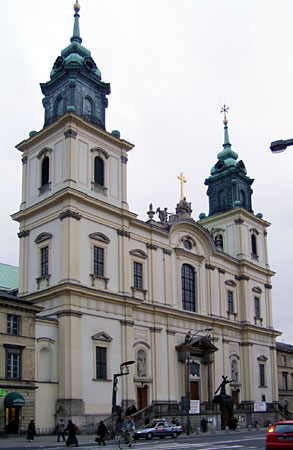- Holy Cross Church, Warsaw
Infobox Historic building

caption=Façade (1990s).
name=Church of the Holy Cross
location_town=Warsaw
location_country=Poland
architect=Józef Fontana
client=Michał Stefan Radziejowski
engineer=
construction_start_date=1682
completion_date=1757
date_demolished=1944
cost=
structural_system=
style=Baroque|Church of the Holy Cross ( _pl. Kościół św. Krzyża, also "Kościół świętokrzyski") is a
Roman Catholic place of worship in downtownWarsaw . Located onKrakowskie Przedmieście , directly opposite the mainWarsaw University campus, it is one of the most notablebaroque churches in Poland's capital. It is currently run by the Missionary Friars ofVincent de Paul .History
As early as the 15th century, a small wooden chapel of the Holy Cross had been erected on the spot. In 1526 the old chapel was demolished and a newer church was erected. Refurbished and extended by
Paweł Zembrzuski in 1615, the church was too small to fit the needs of the growing city. Initially located well outside the city limits, by the 17th century it had become one of the main churches in the southern suburb of the city that had meantime become Poland's capital. In 1656 QueenMarie Louise Gonzaga gave the church to the French order ofMissionary Friars of Vincent de Paul . However, later the same year Warsaw had been captured by the Swedish armies during the Deluge. Pillaged, it was found damaged beyond repair. During the reign ofJohn III of Poland the remnants of the church had been demolished and it was decided to erect a new shrine. In the 1700s it was the origin of the "gorzkie żale " custom.The main building was constructed between 1679 and 1696. Its main designer was
Józef Szymon Bellotti , the royal architect at the Royal Court of Poland. It was financed by abbotKazimierz Szczuka and thePrimate of Poland Michał Stefan Radziejowski . The façade was relatively modest and reminded of Renaissance facades of the nearby churches. The two towers surrounding the façade were initially square-cut. Between 1725 and 1737 two late Baroque headpieces byJózef Fontana . The façade itself was refurbished by Fontana's son, Jakub (in 1756) and ornamented with sculptures byJan Jerzy Plersch .From 1765 the church was one of the most attended by Polish King
Stanisław August Poniatowski . It was also there that the King established the Order of St. Stanisław and bestowed it upon loyal servants annually on May 8. On May 3, 1792, the Polish Diet gathered there on the first anniversary of the May 3rd Constitution. During the Warsaw Uprising of 1794, the stairs leading to the main entrance were destroyed and had to be replaced with new ones designed byChrystian Piotr Aigner .During the times of the partitions, the church gained much importance, especially after the 1861 demonstration in front of it, brutally pacified by the Russian Cossack troops, an event that sparked the
January Uprising .
Wikimedia Foundation. 2010.
